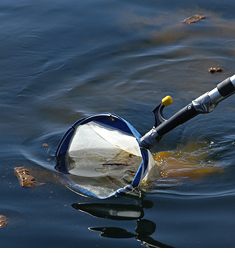


Feeding ecology of right whales has always been of interest to the Grand Manan Whale & Seabird Research Station (GMWSRS) with the first feeding studies beginning in 1983, followed by a habitat comparison between fin whales and right whales and tracking right whales equipped with radio and satellite transmitters as they fed in the Bay of Fundy in the late 1980s. The GMWSRS also provides important logistical support to other researchers when working in the Bay of Fundy.
More recently, research has focused on lipid metabolism in right whales by analyzing the fats remaining in their faecal material. Right whales defecate at the surface and the faeces usually float for several minutes, long enough to be collected in a fine mesh dip net.

Researchers use a fine mesh dip
net to collect faecal samples floating
on the water.
Collection of faecal material can provide an insight into many facets of right whale biology including prey determination (exoskeletal remains of zooplankton can be identified using a microscope), stress and reproductive hormones, biotoxin levels and disease. Dr. Rosalind Rolland from the New England Aquarium in Boston, Massachusetts, has been instrumental in developing these health assessment studies in right whales, and also the use of "scent" detection dogs to locate floating faecal material.
The fact that right whale faeces float stimulated researchers at the GMWSRS to investigate the lipid content and composition of faeces. Metabolism calculations are difficult when the study subjects can not be sampled directly but can be inferred, for example, through the analyses of faecal material and efficiency of digestion, i.e. the amount and type of lipids remaining in faeces. The efficiency of right whales in converting zooplankton lipids can then be applied to metabolic estimates and help understand the daily zooplankton requirement of right whales.

